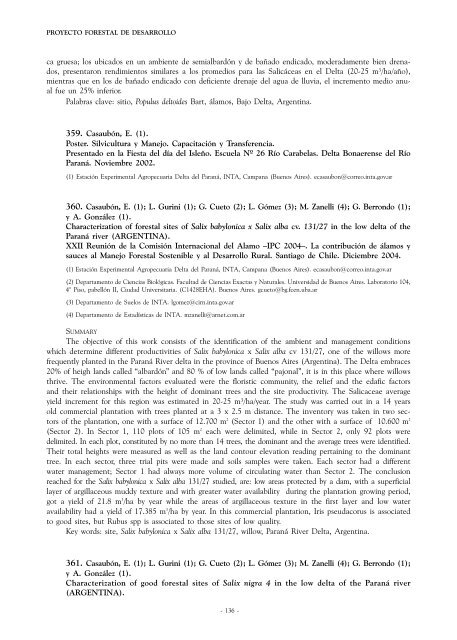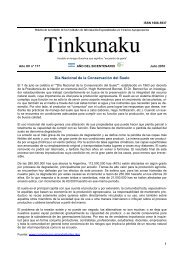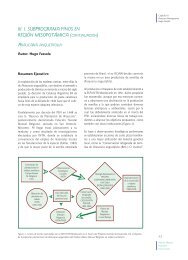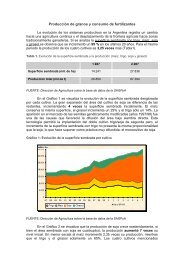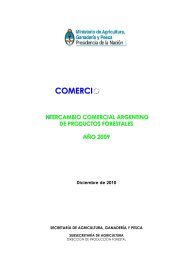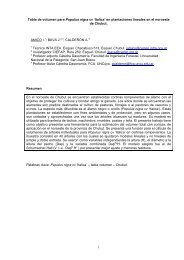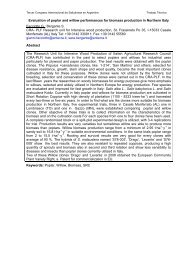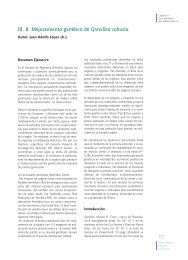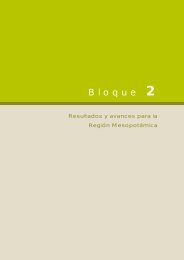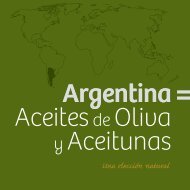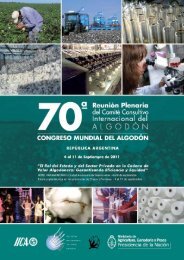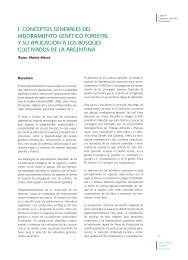catálogo para las regiones pampeana y delta del río parana
catálogo para las regiones pampeana y delta del río parana
catálogo para las regiones pampeana y delta del río parana
Create successful ePaper yourself
Turn your PDF publications into a flip-book with our unique Google optimized e-Paper software.
PROYECTO FORESTAL DE DESARROLLOca gruesa; los ubicados en un ambiente de semialbardón y de bañado endicado, moderadamente bien drenados,presentaron rendimientos similares a los promedios <strong>para</strong> <strong>las</strong> Salicáceas en el Delta (20-25 m³/ha/año),mientras que en los de bañado endicado con deficiente drenaje <strong>del</strong> agua de lluvia, el incremento medio anualfue un 25% inferior.Palabras clave: sitio, Populus <strong>del</strong>toides Bart, álamos, Bajo Delta, Argentina.359. Casaubón, E. (1).Poster. Silvicultura y Manejo. Capacitación y Transferencia.Presentado en la Fiesta <strong>del</strong> día <strong>del</strong> Isleño. Escuela Nº 26 Río Carabe<strong>las</strong>. Delta Bonaerense <strong>del</strong> RíoParaná. Noviembre 2002.(1) Estación Experimental Agropecuaria Delta <strong>del</strong> Paraná, INTA, Campana (Buenos Aires). ecasaubon@correo.inta.gov.ar360. Casaubón, E. (1); L. Gurini (1); G. Cueto (2); L. Gómez (3); M. Zanelli (4); G. Berrondo (1);y A. González (1).Characterization of forestal sites of Salix babylonica x Salix alba cv. 131/27 in the low <strong><strong>del</strong>ta</strong> of theParaná river (ARGENTINA).XXII Reunión de la Comisión Internacional <strong>del</strong> Alamo –IPC 2004–. La contribución de álamos ysauces al Manejo Forestal Sostenible y al Desarrollo Rural. Santiago de Chile. Diciembre 2004.(1) Estación Experimental Agropecuaria Delta <strong>del</strong> Paraná, INTA, Campana (Buenos Aires). ecasaubon@correo.inta.gov.ar(2) Departamento de Ciencias Biológicas. Facultad de Ciencias Exactas y Naturales. Universidad de Buenos Aires. Laboratorio 104,4° Piso, pabellón II, Ciudad Universitaria. (C1428EHA). Buenos Aires. gcueto@bg.fcen.uba.ar(3) Departamento de Suelos de INTA. lgomez@cirn.inta.gov.ar(4) Departamento de Estadísticas de INTA. mzanelli@arnet.com.arSUMMARYThe objective of this work consists of the identification of the ambient and management conditionswhich determine different productivities of Salix babylonica x Salix alba cv 131/27, one of the willows morefrequently planted in the Paraná River <strong><strong>del</strong>ta</strong> in the province of Buenos Aires (Argentina). The Delta embraces20% of heigh lands called “albardón” and 80 % of low lands called “pajonal”, it is in this place where willowsthrive. The environmental factors evaluated were the floristic community, the relief and the edafic factorsand their relationships with the height of dominant trees and the site productivity. The Salicaceae averageyield increment for this region was estimated in 20-25 m³/ha/year. The study was carried out in a 14 yearsold commercial plantation with trees planted at a 3 x 2.5 m distance. The inventory was taken in two sectorsof the plantation, one with a surface of 12.700 m 2 (Sector 1) and the other with a surface of 10.600 m 2(Sector 2). In Sector 1, 110 plots of 105 m 2 each were <strong>del</strong>imited, while in Sector 2, only 92 plots were<strong>del</strong>imited. In each plot, constituted by no more than 14 trees, the dominant and the average trees were identified.Their total heights were measured as well as the land contour elevation reading pertaining to the dominanttree. In each sector, three trial pits were made and soils samples were taken. Each sector had a differentwater management; Sector 1 had always more volume of circulating water than Sector 2. The conclusionreached for the Salix babylonica x Salix alba 131/27 studied, are: low areas protected by a dam, with a superficiallayer of argillaceous muddy texture and with greater water availability during the plantation growing period,got a yield of 21.8 m 3 /ha by year while the areas of argillaceous texture in the first layer and low wateravailability had a yield of 17.385 m 3 /ha by year. In this commercial plantation, Iris pseudacorus is associatedto good sites, but Rubus spp is associated to those sites of low quality.Key words: site, Salix babylonica x Salix alba 131/27, willow, Paraná River Delta, Argentina.361. Casaubón, E. (1); L. Gurini (1); G. Cueto (2); L. Gómez (3); M. Zanelli (4); G. Berrondo (1);y A. González (1).Characterization of good forestal sites of Salix nigra 4 in the low <strong><strong>del</strong>ta</strong> of the Paraná river(ARGENTINA).- 136 -


